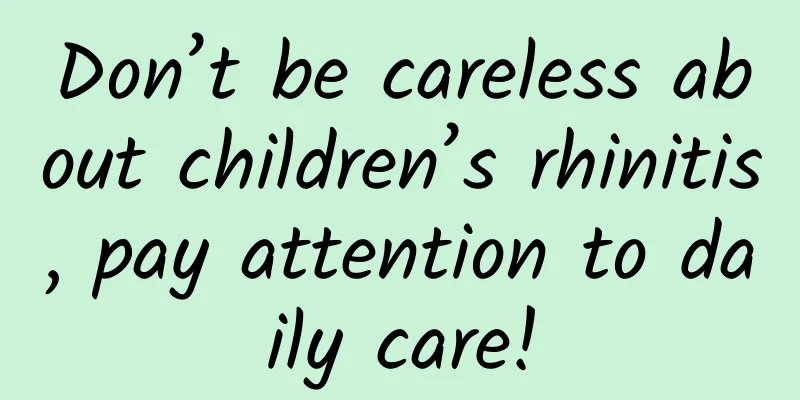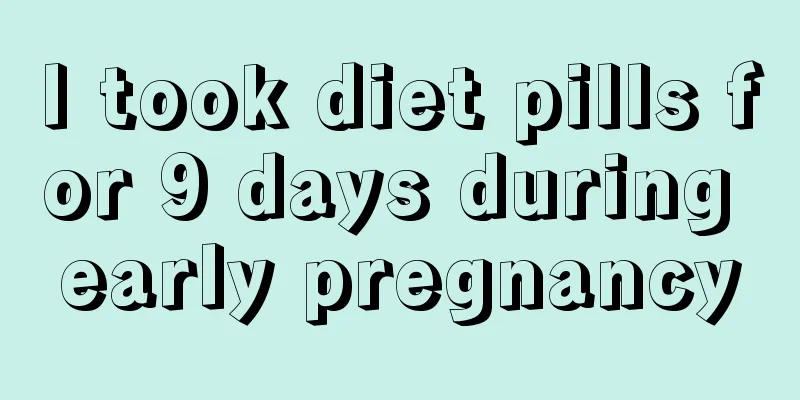Don’t be careless about children’s rhinitis, pay attention to daily care!

|
Author: Gu Qinglong, Chief Physician, Children's Hospital Affiliated to Capital Institute of Pediatrics Reviewer: Liu Zhi, Chief Physician, Xuanwu Hospital, Capital Medical University As we all know, rhinitis is very common among children, and many of them are chronic, which is a long-term process. In the process of long-term chronic rhinitis, there are some precautions that need to be reminded. Let's take a look. 1. What is the first task for children with rhinitis? When a child suffers from rhinitis, the first task is to strengthen his physical fitness, because rhinitis is a local manifestation of the body's health condition in the nasal cavity. The occurrence of rhinitis may be a sign that there is a problem with your physical health recently, and you need to be vigilant. If you are vigilant and make proactive adjustments, your physical health may not continue to deteriorate. For example, if a child has a blocked nose and runny nose today, but you don’t take it seriously, he may cough tomorrow. If you don’t take it seriously after coughing, he may have bronchitis the day after tomorrow. Some children with allergic rhinitis have symptoms in their nose today. If they are not actively controlled, they may have an asthma attack in two days. So sometimes, some nasal manifestations are actually a warning bell from the human body. We must pay attention to these symptoms and pay attention to care in daily life. This is very important. For example, this child's physique is such that he is prone to catching a cold when exposed to cold air, or when the weather turns cooler, and symptoms of rhinitis will appear in the nose. Therefore, the first task is to strengthen the child's physical fitness. 2. How can children with rhinitis improve their physical fitness ? If you want to enhance your child's physique, you need to pay attention to some things in life. In terms of diet, it is often said that eating more green vegetables, eating more fruits, and having a balanced diet are all very important; In terms of exercise, it is very important to strengthen exercise and persist in exercising. In addition, for some children, you should take the initiative to let them accept some stimulation and appropriately increase the stimulation to them, such as washing their faces with cold water. Figure 1 Original copyright image, no permission to reprint One point I want to talk about here is that the living environment and conditions of today's children are obviously different from those thirty or forty years ago. There is heating in the winter and air conditioning in the summer, and the children's adaptability spectrum is becoming narrower and narrower. There is an old saying that goes "train hard in winter and hot summer", which is very helpful for strengthening our body. But now when it gets cold in winter, parents will immediately cover their children with coats, and there will be heating when they enter the house, and air conditioning in summer, so their adaptation spectrum becomes very narrow. If they slightly exceed the range of the adaptation spectrum, problems will immediately arise, so parents should pay attention to this point. There is a saying among the common people that goes "cover up in spring and keep cool in autumn". It is the same principle to keep yourself cool in autumn so that you can adapt. It is also very important to keep yourself warm in summer. 3. Is nasal irrigation beneficial for children with rhinitis? Washing the nose is a particularly hot topic nowadays. What are the benefits of washing the nose? Take allergic rhinitis as an example. If there are more than 100 allergens per unit area of the nasal cavity, you will sneeze. Now there are exactly 110 allergens. 20 of them can be washed away by washing your nose. At this time, there are 90 allergens left, and you may not sneeze anymore. But we must know that washing the nose is only an important auxiliary measure, and this must be made clear. There are various ways to wash the nose now, including local spray, atomization, and flushing. Different children should choose different methods according to their own circumstances. Some babies can easily choke when using a nasal irrigation device. So for babies, if their noses are blocked and there is no medicine available, you can use a spray, just a little spray. If some children have long-term rhinitis, you can also add some medicine, use atomization treatment, etc. The kind of nasal irrigation device that enters from one nostril and exits from the other nostril can generally only be used by children over six years old, and this type of nasal irrigation device is more effective for sinusitis. 4. How do children with rhinitis blow their noses correctly? Blowing your nose is a topic that is often discussed. Because the back of the nose and the posterior nasal cavity are connected, when blowing your nose, you need to press one nostril and lift the soft palate to seal the nasopharyngeal cavity. At this time, if you blow your nose again, the snot will come out from the front. Therefore, the correct way is to press one nostril and blow the snot on the other side. Figure 2 Original copyright image, no permission to reprint Do not press both nostrils at the same time. If you press both nostrils with both hands, the mucus will have nowhere to go out and will flow backwards when you blow your nose. Because there is a pharyngeal opening of the Eustachian tube behind the nasal cavity, which is connected to the middle ear, when you blow your nose, the mucus will enter the middle ear cavity through the pharyngeal opening of the Eustachian tube behind the nasal cavity, thus causing acute otitis media. Therefore, for children with rhinitis, improper nose blowing is an important cause of acute otitis media. |
>>: If your child keeps coughing, be careful it may be rhinitis!
Recommend
Why do women’s calves feel sore and weak?
Nowadays, women love beauty very much and everyon...
What to do if you have pharyngitis during early pregnancy
Nowadays, as the air quality is getting worse and...
What causes premature ovarian failure?
Premature ovarian failure mainly occurs in some m...
What is the dietary treatment for anemia in women?
Some women often suffer from severe anemia sympto...
What kind of meat is better for fried chicken? Which part of the meat is suitable for fried chicken?
We all know that fried chicken is a common snack....
What are the applications of magnets in life? The principle of magnets
Magnets are widely used in people's daily lif...
What should pregnant women with anemia eat?
What should women with anemia eat? Of course, eat...
Why do I feel breast swelling before my period?
Some female friends will feel breast distension a...
A woman with a fleshy nose
We know that a girl's appearance is very impo...
What should I do if I have too many zongzi to eat? Can I still wrap zongzi if the zongzi leaves are moldy?
Due to different eating habits in different place...
What are the benefits of scraping the back for women?
Traditional Chinese medicine culture is so profou...
Is there any disease associated with frequent urination at night? How to relieve frequent urination at night?
It is normal to get up at night to go to the bath...
Picture of 4-month-old fetus in the belly
Nowadays, pregnant women are more concerned about...
Will hemorrhoids get better after giving birth?
Taking into account the special physical conditio...









